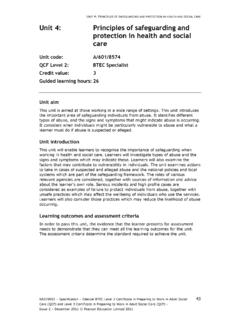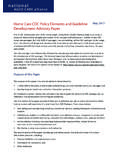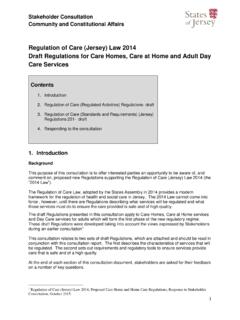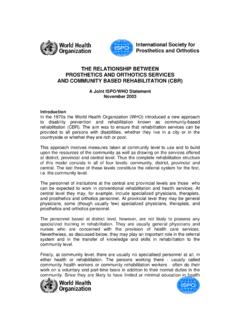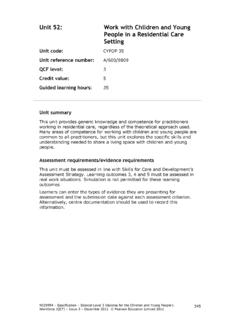Transcription of Unit 9: Lead and Manage Group Living for Children
1 Unit 9: Lead and Manage Group Living for Children Unit code: P4. Unit reference number: A/602/3175. QCF level: 5. Credit value: 6. Guided learning hours: 43. Unit summary The purpose of this unit is to assess the learner's knowledge, understanding and skills required to lead and Manage the Group Living for Children and young people. Assessment requirements This unit must be assessed in accordance with Skills for care and Development's QCF Assessment Principles. Learning outcomes 2, 3, 4 and 5 must be assessed in the work setting. Assessment methodology Learners can enter the types of evidence they are presenting for assessment and the submission date against each assessment criterion.
2 Alternatively, centre documentation should be used to record this information. N031277 Specification Edexcel Level 5 Diploma in Leadership for Health and Social care 101. and Children and Young People's services (England) (QCF) Issue 2 April 2012. Pearson Education Limited 2012. Content 1 Understand the legal, policy, rights and theoretical framework for Group Living for Children and young people Theoretical approaches for Group Living : how to develop and implement a social pedagogical approach and outcomes-focused service provision for Children and young people in Group care ; how to ensure the availability of psycho-social approaches and therapeutic programmes for Children and young people needing these eg counselling, behaviour management programmes.
3 How to maintain evidence-based practice and keep up to date with current and emerging changes in legislation and the implications for practice and management in Group care for Children and young people Legislation, policy and rights for Children and young people: United Nations Convention on the Rights of the Child (UNCRC); key legislation for protecting and safeguarding eg the Children Act 1989; legislation to promote wellbeing and improved outcomes for Children and young people eg Children Act 2004, Children and Young Person's Act 2008, the five outcomes of the Every Child Matters agenda be healthy, stay safe, enjoy and achieve, make a positive contribution, achieve economic wellbeing; the right of access to universal, targeted and specialist services across health, social care and education that are available for Children and young people eg immunisation and health screening, CAMHS.
4 Impact of legislation on Group Living : how to use the legislative frameworks to carry out an audit of policies and procedures to ensure compliance in relation to security procedures, access and visiting rights, safeguarding policies, data and information management and security, inter-agency and joint working; how to use the legislation and policy to promote the rights of Children and young people within the setting, maintain and enhance their physical, social and emotional wellbeing and improve individual outcomes; how to balance safety and security with Children and young people's rights to privacy and empowerment Analyse impact of current policies: comparing objectives with outcomes.
5 Identifying benefits; identifying improvements 102 N031277 Specification Edexcel Level 5 Diploma in Leadership for Health and Social care and Children and Young People's services (England) (QCF) Issue 2 April 2012. Pearson Education Limited 2012. 2 Lead the planning, implementation and review of daily Living activities for Children and young people Supporting daily Living activities that meet Children and young people's requirements: implementing management approaches that enable staff to identify and develop daily Living routines and activities that meet Children and young people's needs for security, safety, companionship and privacy and which meet their development needs and help them engage in positive relationships eg modelling, shadowing, staff training and development, linking theory to practice eg theories of child and adolescent development to age-appropriate activities Ensuring Children and young people are central to decisions.
6 How to develop and use policies and procedures to ensure Children and young people are engaged in and central to decisions about their care and daily Living activities, on both an individual and collective basis; formally through representation at staff meetings; informally eg through sharing of chores, making choices and agreeing plans with others; supporting Children and young people to review their arrangements and activities eg using peer mentors; overseeing staff input Overseeing review of daily activities: ensuring outcomes of activities meet expectations of Children and young people; identifying need for change, improvements 3 Promote positive outcomes in a Group Living environment Positive outcomes: the importance of recognising how Children and young people's life experiences influence their behaviour and responses to Group Living ; strategies for promoting positive outcomes including ways of empowering Children and young people so they are active participants in their own care eg access to advocacy, peer mentors; the importance of minimising stress and feeling safe.
7 Ways of supporting staff to help Children and young people develop positive and trusting relationships with others inside and outside the setting; identifying positive outcomes for individual Children or young people eg taking personal responsibility, identifying and setting self-directed goals; the importance of achieving these to the development of self-esteem and resilience Evaluation: working with staff to ensure that each child and young person's personal information includes their clearly identified and documented aspirations, goals, likes and preferences, that their overall developmental progress is assessed and documented, reviewed and changed with full participation of the child or young person so that their individual outcomes can be promoted Conflict resolution: ensuring tension is minimised through effective communication strategies.
8 Ensuring that mechanisms are in place to Manage disagreement, conflict, complaints and rewards; ensuring staff are aware of situations in which conflict is likely and have the skills to defuse and deal with these, including mediation, negotiation, successful behaviour management techniques that are in line with legal and operational guidelines eg on restraint N031277 Specification Edexcel Level 5 Diploma in Leadership for Health and Social care 103. and Children and Young People's services (England) (QCF) Issue 2 April 2012. Pearson Education Limited 2012. 4 Manage a positive Group Living environment Maintaining the physical environment: understanding the links between the physical environment and emotional wellbeing, the importance of high quality furnishings, fixtures and fittings to self-esteem and the promotion of self- care ; how this leads to positive outcomes for Children and young people as they learn to respect their environment Working patterns: know the potential effects of different working patterns on the development of relationships eg shifts; developing methods to Manage this and minimise disruption eg key worker system.
9 Awareness of the manager's role in modelling appropriate approaches to developing and maintaining relationships with Children and young people that are mutually respectful, awareness of power dynamics and the negative impact of these on the development of relationships with Children and young people Recommend changes: implementing changes as required eg where there has been disruption, disturbance or dispute to relationships Workforce development: developing and implementing a workforce development plan to ensure succession planning; implementing appropriate training and development opportunities eg theoretical approaches to child and adolescent development, attachment and reactive attachment disorder and the impact of this on relationships, Group dynamics, to Group Living , methods available for raising staff awareness of these Professional boundaries: ensuring staff are aware of and apply professional boundaries in relationships with Children and young people and the implications of not doing so for all concerned Raising staff awareness of Group dynamics: training and development.
10 Opportunities for impact of Group dynamics on Group Living environment Monitoring and evaluation: ensuring clear lines of accountability for managing rotas and working patterns; recognising the importance of regular monitoring and review; monitoring resources and resource allocation to ensure that positive outcomes for individuals can be achieved and maintained 104 N031277 Specification Edexcel Level 5 Diploma in Leadership for Health and Social care and Children and Young People's services (England) (QCF) Issue 2 April 2012. Pearson Education Limited 2012. 5 Safeguard Children and young people in a Group Living environment Policies and procedures for safeguarding: safe recruitment policies.


